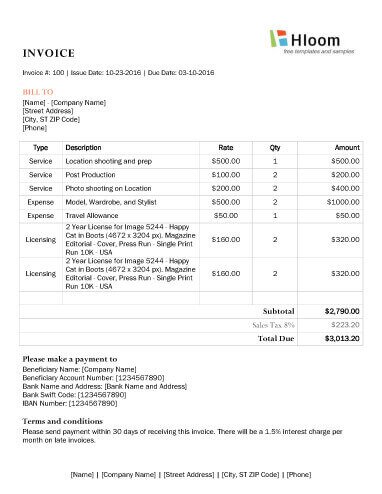Content

When a discount is included for early payment, this is often cited in a specific way as well. This is sometimes seen as mentioned above – with the use of ‘net xx’ to indicate the number of days payment must be made after the invoice is issued. This is often combined with the details about an early discount, which provide the percentage of the discount within the number of days it will be honoured, such as ‘5/14’. Due upon receipt indicates you expect your customer to pay you once they receive the invoice. Historically, this meant that your customer would pay you during their next check run. However, with online payment capability, your customer now really can pay you upon receipt.
That can cause a drag on your other administration work, so be sure to factor this into your planning and accounting strategies – and set up the most time-efficient systems you can. Send your invoice as soon as possible, the sooner a client receives an invoice the sooner they will make payment. It also means they will receive it when the value of your work is still fresh in their mind. Accounting software that lets you create professional recurring invoices will streamline the invoicing process. Some customers may expect longer payment terms for bigger bills, but you may be able to negotiate with them. If they ask for a discount, for example, consider requesting faster payment in return. – This might sound drastic, but if a customer consistently pays you late, they may be more of a threat to you than an asset.
However, for an entrepreneur just starting out, it can be difficult to know what terms to set to get paid faster and establish positive relationships with your customers. Your industry and client history are key components in choosing the right invoice terms.

Save time and effort manually entering data for multiple invoices. With accelerated invoicing, you can easily duplicate similar invoices for multiple customers. If you’re like me and many of my clients, you’ll find – even after just a few years of running your business – that dealing with collections for non-payment is too cumbersome and time-consuming. There are plenty of good companies out there who pay their bills and don’t monkey around with their suppliers and service providers. Focus on them and you’ll sleep well – and with more cash in the bank. You can have different terms for payment depending on the customer. Your payment terms on any single invoice should be clear, understandable, and consistent.
What Are Payment Terms On An Invoice?
Businesses, regardless of the industry or size, require regular cash flow from their clients and the customer to pay their expenses, such as their employees’ salaries and the utilities. Without these bills, you won’t be compensated for the services rendered or products sold, which in turn means that you won’t be able to handle your expenses. consider allowing your clients to set up automatic bill payments, so they can schedule payments automatically and not have to think about paying you every time you email an invoice. Even small overdue penalties, such as a late fee of 2% interest per month, can give clients added incentive to pay their invoices on time.
Again, this is a last resort but an option that you may want to consider only after you have tried the first two options that I noted above. Crystalynn Shelton is an Adjunct Instructor at UCLA Extension where—for eight years—she has taught hundreds of small business owners how to set up and manage their books. Crystalynn is also a CPA, and Intuit ProAdvisor where Crystalynn specializes in QuickBooks consulting and training. Prior to her time at Fit Small Business, Crystalynn was a Senior Learning Specialist at Intuit for three years and ran her own small QuickBooks consulting business. We have included the most frequently asked questions about invoice terms in this section. It will help in efficient and clear communication with the customers eliminating confusion arising from the financial terminologies.
And whether you’re a small business owner or part of a large procurement and accounts team, getting paid means sending invoices and keeping cash flowing into your coffers on a reasonable schedule. For example, while some industries may consider a fixed amount to be standard, like a $50 fee for every 10-days past due, others might have a standard percentage, such as 5% for every 15-days past due. Another way to help determine fees and penalties is to consider the true cost of late payments to the business. For example, if a late payment means you can’t pay your rent on time, and your landlord charges a $100 late penalty, it might make sense to establish a $100 late payment fee. In order to get paid on time, you first have to define what “on time” means. For some, that could mean instantly, for others that could mean 90 days, but for most “on-time” falls somewhere in between.
That’s because your payment terms define when and how you’ll be compensated. So, if you choose the wrong terms, you could be doing some serious harm to your cash flow. Hitting a customer with an unexpected late fee could cause more animosity than it’s worth. However, it’s perfectly fine to state your terms for late payments right up front and then be sure to itemize them on the next bill. You may be tempted to put “Immediate payment,” but that can be confusing to some clients.
- I have business expenses and owe a house and car payment due the first part of each month.
- Make sure you clearly list your company’s name and mailing address or PO box on your invoices so clients know exactly where to send checks.
- This is especially challenging for small businesses or start ups who cannot afford the payment lag.
- I own a cleaning business and I invoice the property management same day when cleaning service is finished .
- For instance, if some of the goods received by the purchaser were damaged, the seller is likely to grant a sales allowance.
Looking for the best tips, tricks, and guides to help you accelerate your business? Use our research library below to get actionable, first-hand advice. Product Reviews Unbiased, expert reviews on the best software and banking products for your business.
Most Importantly, Give Customers An Easy Way To Pay
The simplest way to define your payment policies is to make the process as convenient as possible for the customer. For instance, you may be accustomed to receiving paper checks or cash. However, expanding your accepted payment methods will increase the likelihood of on-time payments. Two of the more modern payment methods you’ll want to consider are smart invoices and mobile payments. Installment agreements are similar to line-of-credit payment terms, except they’re cash-based. Installment agreements could be based on time — every three months, for example — or upon delivery of a specific part of the project.
Offering your clients a discount for early payment of their invoices gives them an incentive to pay you sooner by rewarding them for prompt payment. For example, a common reward is to offer a 2% discount off the invoice total if it’s paid within 10 days, even though the invoice is actually due 30 days from the issuing date. This is one of the most common payment terms for small businesses and freelancers. However, if you’re working with online invoicing software like Debitoor, there are dedicated sections for information such as notes intended for the customer, as well as payment terms. It’s even possible to include these messages by default, so that there’s no need to type them in each time. For example, some businesses might choose not to provide a due date and instead request cash on delivery or even up-front payment. Of course, it’s unlikely every customer will pay on time, but if you screen customers properly, chances are late payments will be at a minimum.
Create And Send Online Invoices
Sometimes they neglected to tell you that there’s some specific information they need for their own system, like a PO number. Or it could be that your invoice got lost in the inbox of “Carol in Accounting” who’s been on vacation.
There is almost always a good reason why your invoice hasn’t been paid, so don’t be shy about asking. To make it easier to send these polite reminders, QuickBooks allows you to create automated messages that you can send your clients.
This is especially challenging for small businesses or start ups who cannot afford the payment lag. Hence, the need arises for optimal payment terms and clarity in payment term representation on invoices.

I have business expenses and owe a house and car payment due the first part of each month. Change your billing cycle to monthly and email your invoices so that they receive it no later than the 1st and that way you should be on the payment schedule for the 15th of each month. I own a cleaning business and I invoice the property management same day when cleaning service is finished . But somehow it takes 3 to 4 weeks until I get paid and this is causing me a huge cash back flow in keeping up with my bills . I have to buy cleaning supplies , need gas , need to pay insurance and have personal expenses as well like paying rent etc. For example, when a customer pays 30 days late, you may end up having to borrow money through a factoring company to cover your own obligations. The cost of doing that on a monthly basis is about 4% or more on average.
If you use invoice factoring, you’re selling an unpaid invoice to a factoring company, who will pay you a set percentage of the value of the invoice. The collection activity then shifts to the factoring company, which keeps their portion, while sending you the balance once they receive an invoice payment from your customer. Invoice factoring is not always the best solution for collecting on invoices, but for small businesses with limited cash flow options available, it can get cash into your bank account quickly.
The best-run businesses have control over their cash flow, tax planning, and growth position. Knowing how much money is going to hit your account and when it’s going to do so is essential to cash flow predictability. Proper cash flow predictability allows you to determine the best time to expand or scale back your business. Invoices serve as a schedule, outlining when your organization will receive income.
To eliminate the risk of bounced or lost checks, you might encourage your customers to make electronic payments. State the penalty for returned checks, such as a returned check fee and interest on the late payment.

